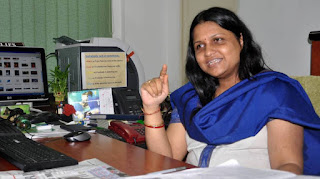The Periyar Tiger Reserve (PTR) won the
U.N.-India Biodiversity Governance award, instituted by the Government of India
and the United Nations Development Programme (UNDP), for the best managed
protected area of the country recently.
Padma Mahanti, IFS, who served as Deputy
Director, PTR, was hugely responsible for initiating innovative concepts of
eco-tourism and in following up effectively some of the programmes introduced
at the PTR. Padma was member secretary of the Periyar Foundation. She won the
Green Guard Anti-Poaching award in 2007.
Padma, who is now Regional Passport Officer in
Odisha, recently released a book of poems titled Mist
and Musings, which narrates in
verse and interludes in prose the story of her life, experiences in Periyar.
In an e-mail interview Padma shares her
memories of Periyar, her thoughts on wildlife management and more.
Excerpts from the interview.
What
does Periyar mean to you?
Periyar was my first independent posting after
my training at the Wildlife Institute of India (WII). And it was love at first
sight. The streams that came to life during monsoon fascinated me. I still
dream of them. There’s a deep connect with Periyar.
Were
you always a wildlife enthusiast or did Periyar transform you?
Wildlife interested me more than the other
subjects of forest management. That’s why I went ahead to complete my
post-graduate diploma in wildlife management in 2005. Periyar gave an
opportunity to implement whatever I was trained for in the WII.
As a
wildlife professional, and not as a poet, how do you evaluate your experience
here?The job must have been challenging too?
Yes. You had to be on guard always. The
problems were undefined. From human-wildlife conflict, safety of tourists,
forest fire, poaching, sandal smuggling, pressure on forest land, to the issues
of the forest dwellers dependent on the park management for their livelihood,
each day was a challenge.
Looking
back was it worth the effort?
We achieved a lot, but achievements are not
always quantifiable. They are often special moments, endearing memories. And my
tenure in Periyar was full of such instances. Yes, looking back it was
satisfactory. Training local youth in tiger monitoring through the use of
camera traps and GPS, reviving nature clubs, revisiting and modifying all eco-development
committees with a plan for five years were some great initiatives.
The
tourist is the subject of one of your poems. He can be a source of concern in a
protected sanctuary. Were the tourists generally insensitive?
In the Periyar Tiger Reserve tourism was still
low impact as it is carried out in about 2.5 sq. km area of the entire reserve.
The rest is eco-tourism in its real sense. However, there used to be mindless
jeep rides in parts of the tiger reserve by other agencies. I hope it has
stopped now or at least regulated.
What
steps would you suggest to balance this tourist-wildlife issue, especially in
the wake of the new rules framed with regard to tiger sanctuaries?
In the present scenario tourism has to be used
as a tool to unite voices for conservation. It should be low impact and
responsible; nature friendly and totally guided. Vehicles should never be
allowed inside protected areas except the buffer zone. Sensitisation classes
should be arranged for tourists before they enter the tiger reserves. They
should be made to realise that tourism inside the tiger reserves is a sensitive
and responsible job.
The
tribes were successfully integrated into the protection and conservation of the
jungles. How do you view this move?
Periyar has six indigenous tribes, Mannans,
Paliyans, Uralis, Malapandarams, Malayarians and Ulladans. Efforts like
organising the Mannan and Paliyan fishermen into eco-development committees and
regulation of fishing activities inside the park were taken up. They were
trained in research, wildlife health monitoring; protection of park and in
hospitality sector.
In Periyar all eco-tourism programmes are
protection-oriented and each one was need based. My efforts were to explore
linking of local economy like pepper cultivation in the tribal hamlets directly
with the global market by weaning out middlemen. Periyar Foundation played a
pivotal role in the experiment of pepper export by Vanchivayal tribal colony to
Germany.
Poachers
were also transformed ?
In 1998, a group of 22 cinnamon bark smugglers
in Periyar, were transformed in mainstream society. In 2004, when I joined
Periyar as the Additional Deputy Conservator of Forests efforts were on to
transform a group of poachers from the neighbouring Theni District, in Tamil
Nadu. I was lucky to be a part of this process from the very start. I took it
forward by organising these people into an eco-development committee and making
them a part of the Periyar Protection Force. This was India’s first
trans-boundary initiative in eco-development.
How did
Mist and Musings come about?
Writing was a way to escape from the
depression I suffered following my father’s demise. It took me 18 months to
bring out this book. I felt like I was reliving by life once again. The entire
proceeds from the sale of this book will go to people protecting the jungles
and to help conservation.
(The Hindu)






No comments:
Post a Comment